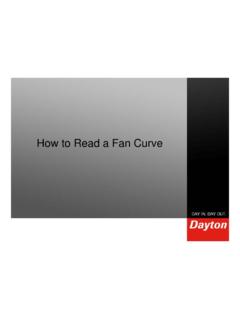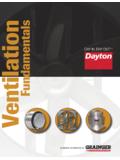Transcription of Ventilation Fundamentals - Solutions for Air
1 VentilationFundamentalsAvailable exclusively at .All Dayton products available exclusively at All Dayton products available exclusively at . Ventilation FundamentalsTable of ContentsIntroduction to Fan Selection Page 3 Terms & Tech Data Centrifugal Blowers Propeller fans and Duct fans Reading Performance Charts Page 4 Cross Reference Chart Page 6 Fan Selection Based on Fan Application Page 7 General Commercial Ventilation Page 8 Commercial Kitchen Ventilation Page 10 General Industrial Ventilation Page 12 Determining CFM Page 14 Determining Static Pressure Page 15 Preliminary Selections/Stability Considerations Page 16 Sound Levels/Motor Horsepower Page 17 Installation Page 18 Fan Performance Page 19 Fan Dynamics and System DynamicsSafety Practices Page 23 Basic Fan Laws Page 24 Call or stop by your branch.
2 Or go online to Dayton products available exclusively at All Dayton products available exclusively at When you re ready to order: Call or visit your local branch, or go online at fans and Duct fans Propeller Fan ( axial Fan) An air moving device in which the air flow is parallel or axial to the shaft on which the propeller is mounted. These fans have good efficiency near free air delivery and are used primarily in low static pressure, high volume applications. As SP is increased, HP increases and CFM decreases. Usually mounted in a venturi, ring, or other housing featuring simple construction and low Fan (Tubeaxial) An air moving device in which the air flow is parallel or axial to the shaft on which the propeller is mounted. The propeller is housed in a cylindrical tube or duct. This design enables duct fans to operate at higher static pressures than propeller fans .
3 Commonly used in spray booth and other ducted exhaust systems. As SP is increased, HP increases and CFM & Tech Data HVAC Terminology AMCA (Air Movement and Control Association, Inc.) A nationally recognized association that establishes standards, tests and certifies the performance of air moving devices. A-Weighted A term which refers to the single number logarithmic summation of the 8 octave bands that have been adjusted to account for response of the human ear to sound pressure level. BHP (Brake Horsepower) Fan horsepower required. Btu (British Thermal Unit) The amount of energy or heat required to raise the temperature of one pound of water one degree Fahrenheit. BtuH One Btu per hour. CFM (Cubic Feet Per Minute) A measure of volume flow rate, or air moving capability, of an air moving device. Volume of air moved per minute.
4 DB (Decibel) A measure of the sound produced by an air moving device. dB(A) Sound level reading on the A-weighted scale of a sound meter. This A-weighting adjusts response of the meter to approximate that of the human ear. Free Air Delivery The conditions existing when there are no effective restrictions to air flow (no static pressure) at the inlet or outlet of an air moving device. HP (Horsepower) The power required to drive an air moving device. HP required varies with system conditions. LwA A value representing the logarithmic summation of all 8 octave band values, adjusted to represent the effect of the A weighted network. This single number rating provides a useful number for comparison. Octave Bands The range of sound frequency that can be heard is divided into 8 octave bands. Plenum Chamber An air compartment maintained under pressure to serve one or more distributing ducts.
5 RPM (Revolutions Per Minute) Speed at which the shaft of an air moving device is rotating. Sone An internationally recognized unit of loudness. Sones signify, in a single number, the total sound output of the unit being tested. One sone is approximately equal to the sound of a modern refrigerator in a kitchen. A 3-sone fan, for example, sounds twice as quiet to the human ear as a 6-sone fan. Sound Power Level The acoustic power radiating from a sound source, expressed in decibels. SP (Static Pressure) A measure of the resistance to movement of forced air through a system or installation, caused by ductwork, inlets, louvers, etc. Measured in inches of water gage ( ); the height, in inches, to which the pressure will lift a column of water. For a given system, static pressure varies as the square of the flow rate.
6 Thus, if flow rate is doubled, system resistance or static pressure is increased four times. TS (Tip Speed) The speed of the tip of a fan wheel or prop measured in feet per minute. Venturi The formed inlet of a fan used to direct laminar airflow into the fan to improve to Fan SelectionCentrifugal Blower Centrifugal blowers are air moving devices in which the air flow is perpendicular to the shaft on which the wheel is mounted. The wheel is mounted in a scroll-type housing, which is necessary to develop rated pressures. The four classes of centrifugal blowers are determined by wheel blade position with respect to the direction of rotation. As SP is increased, HP and CFM decrease. Forward Curve (FC) The tips of the blades are inclined in the direction of rotation; the most common type of centrifugal blower. Normally used in residential heating and air conditioning systems and light-duty exhaust systems where maximum air delivery and low noise levels are required.
7 Capable of pressures up to approximately 1 1/2 SP. Backward Incline (BI) The tips of the blades are inclined away from the direction of rotation. Used in commercial/industrial, heavy-duty heating/cooling systems that require heavy-duty construction, non-overloading characteristics and stable air delivery. These blowers operate at higher efficiencies than forward curved blowers. Not as quiet as forward curve blowers because they operate at higher speeds. Can be used in systems up to 3 static pressure. Smaller diameter wheels are supplied with flat blades; larger diameter wheels are supplied with air foil blades to improve efficiency. Radial Blade Has straight blades that are, to a large extent, self-cleaning, making them suitable for various kinds of material handling and particle-and-grease-laden air. Wheels are of simple construction and have relatively narrow blades.
8 They can withstand the high speeds required to operate at higher static pressures (up to 12 ) but usually are noisier than FC or BI blowers. Inline (Square Centrifugal Fan) Air flow is developed as in a centrifugal blower, but after leaving the impeller the air is contained in a square housing and, by means of turning vanes, is discharged in an axial direction. Employs single-inlet centrifugal wheels, usually with backward inclined blades. The square centrifugal fan has performance characteristics similar to a centrifugal blower and the compact physical configuration of the tubeaxial fan. Can be vertically or horizontally mounted, thus providing a simpler installation by minimizing need for duct turns and Fan ( axial )5AV95 Duct Fan (Tubeaxial)3C411 Forward CurveForward Curve5C094 Backward InclineBackward Incline3C074 RadialRadial3C108 InlineInline5AV78 All Dayton products available exclusively at All Dayton products available exclusively at 4 Reading Performance Charts The most important part of selecting a fan is the ability to read the performance charts.
9 Most of the performance charts in the catalog are similar and are read in the same manner. The selection procedure for direct drive and belt drive fans are slightly different. Belt Drive Selection Assume that a job requires a belt drive roof exhauster to move 2400 CFM against SP. Refer to the performance model at the bottom of this page. Start at the top of the chart with the SP column. (All numbers in this column correspond to SP.) Now follow the column downward until a value is found that slightly exceeds 2400 CFM. In this case, 2710 is the first box that meets the performance this performance point, the sone value is and the fan Bhp required is By following the row to the left, we can determine fan rpm and the fan stock number. In this case, the fan rpm is 1545 and the stock number is 7A557.
10 Notice that 7A557 is not the only model to choose from. If we follow the SP column down further, we find a performance point of 2434 CFM. At this point, the sone value is and the Bhp is Following across to the left we find the rpm to be 945. The stock number for this fan is 7A559 with a 1/3 hp motor. Both the 7A557 and the 7A559 will perform the air movement task equally as well. However, the sound generated by the fan may have to be considered. Compare the sone values: sones for the 7A557 and sones for the 7A559. The 7A559 is about 34% quieter. Where a low sound fan is required, the 7A559 would be a better selection. If loudness is not a factor, the 7A559 would be a better selection because it is less expensive. Another factor to consider in fan selection is the dimension of the base (ie. Curb cap size).



